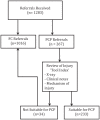Validation of the Primary Care Pathway Model for Management of Orthopedic Injuries: Results of a Prospective, Queensland Study
- PMID: 33106089
- PMCID: PMC7786413
- DOI: 10.1177/2150132720967228
Validation of the Primary Care Pathway Model for Management of Orthopedic Injuries: Results of a Prospective, Queensland Study
Abstract
Objective: A "virtual fracture clinic" (VFC) is viewed as a safe, cost effective method of managing suitable low risk orthopedic injuries without direct orthopedic review. This method is used throughout the Glasgow Royal Infirmary (GRI) and National Health System (NHS) as a cornerstone for efficient patient care. This study assessed the outcomes of a newly implemented Queensland based Primary Care Pathway (PCP) for management of simple orthopedic injuries.
Methods: A prospective cohort was formed of patients presenting over a 4-week period with an acute orthopedic injury to either the Emergency Department (ED) or Primary Care Providers within the Logan Hospital catchment in Queensland, Australia. Patients were triaged to either a PCP management protocol with General Practitioners (GP), Allied-Health Professionals (AHP) or to a traditional in-person Fracture Clinic (FC) orthopedic review. Patients were followed for 6-months. Data were collected about epidemiology, complications, appropriate allocation, and injury type.
Results: A total of 1283 patients were referred over the study period, of which 267 were triaged to PCP management. ED referrals accounted for 62.5% of appropriate referrals to either clinic. Upper limb injuries were the most common conditions managed through the PCP. Patients managed by the PCP model of care experienced a 4.29% complication rate over the 6-month follow-up period.
Conclusion: The PCP model of care is effective in managing criteria specific, low risk orthopedic injuries with a low rate of complications (4.29%) without direct orthopedic FC review. Use of a PCP reduces demand on hospital resources, and provides a safe, cost-effective alternative to a resource-restricted outpatient service.
Keywords: cost effectiveness; fracture; injuries; orthopedics; primary care; trauma.
Conflict of interest statement
Figures
References
-
- Australian Institute of Health and Welfare. Emergency Department Care 2017-18: Australian Hospital Statistics. 2018. https://www.aihw.gov.au/reports/hospitals/emergency-department-care-2017.... Accessed June10, 2019.
-
- Robinson A, Pillai A, Alqubaisi M. Evaluating the effectiveness of virtual fracture clinics for ankle injuries. Res Rev Insight. 2018; 2:1-5.
-
- Ferguson KB, McGlynn J, Jenkins P, Madeley NJ, Kumar CS, Rymaszewski L. Fifth metatarsal fractures—is routine follow-up necessary? Injury. 2015;46:1664-1668. - PubMed
MeSH terms
LinkOut - more resources
Full Text Sources
Medical



